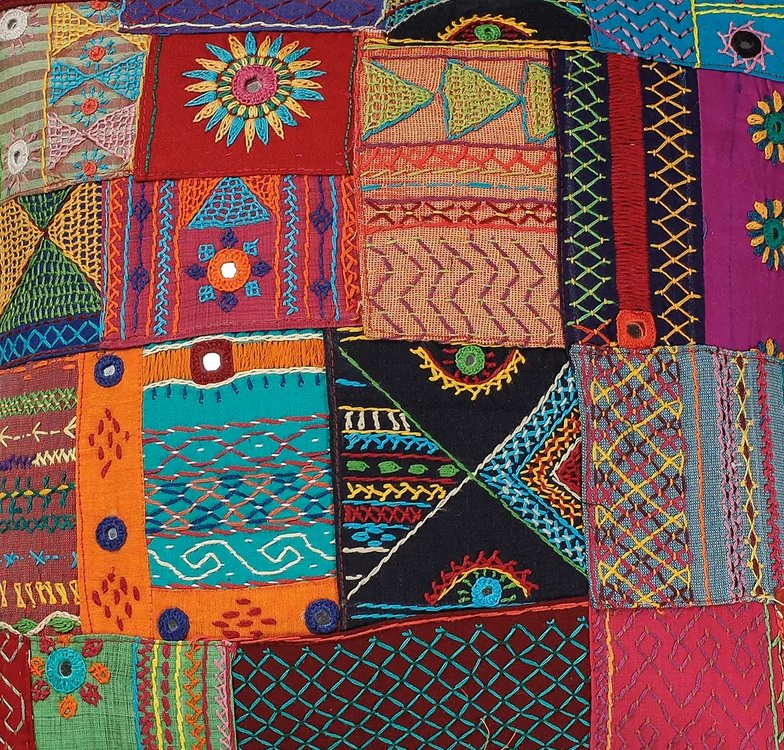In the vibrant tapestry of Indian heritage, Lambani embroidery stands out as a testament to centuries-old traditions and artistic excellence. Rooted deeply in the cultural fabric of Karnataka and neighboring regions, Lambani embroidery encapsulates the rich history and intricate craftsmanship of the Lambani community. Let’s delve into the captivating world of Lambani embroidery, exploring its origins, techniques, and cultural significance.
Unveiling the Origins
Lambani embroidery traces its origins to the Lambani or Lambada tribe, a nomadic community with a rich history spanning centuries. Historically, the Lambani people migrated from Rajasthan to various parts of India, settling predominantly in Karnataka, Andhra Pradesh, and Maharashtra. Along their migratory routes, they brought with them a unique embroidery tradition, blending elements of their cultural heritage with local influences.
The Artistry Unveiled: Techniques and Styles
At the heart of Lambani embroidery lies meticulous craftsmanship and a deep reverence for tradition. Traditionally, Lambani women practice this art form, skillfully incorporating vibrant colors, intricate motifs, and diverse stitching techniques into their creations.
- Mirror Work (Abhla Bharat): One of the most iconic features of Lambani embroidery is its lavish use of mirrors or ‘abhla’ to embellish the fabric. Mirrors, intricately stitched onto the cloth, reflect light and add a dazzling allure to the finished pieces.

- Chain Stitch (Mothi Bharat): Chain stitch is another prominent technique used in Lambani embroidery. Delicate chains of colorful thread form elaborate patterns, depicting motifs inspired by nature, folklore, and religious symbolism.

- Patchwork (Kaudi Bharat): Lambani artisans often incorporate patchwork into their embroidery, creating visually striking contrasts and textures. Pieces of fabric are meticulously arranged and stitched together, adding depth and dimension to the final design.

Cultural Significance and Symbolism
Beyond its aesthetic appeal, Lambani embroidery holds profound cultural significance for the Lambani community. Each stitch and motif carries stories of heritage, identity, and resilience, serving as a link to their ancestral roots. For Lambani women, embroidery is not merely a craft but a form of expression, a way to preserve their cultural heritage and pass down traditions to future generations.
Preserving Tradition in a Modern World
In today’s fast-paced world, Lambani embroidery faces numerous challenges, including dwindling patronage and the encroachment of modernization. However, grassroots initiatives and efforts by artisans and enthusiasts aim to preserve and promote this invaluable cultural heritage. Collaborations with designers, workshops, and cultural festivals serve as platforms to showcase Lambani embroidery on a global stage, ensuring its legacy endures for generations to come.
Conclusion
Lambani embroidery stands as a testament to the enduring spirit of creativity, resilience, and cultural pride. With its vibrant colors, intricate motifs, and rich symbolism, it weaves together the threads of tradition and innovation, connecting the past with the present. As we celebrate the beauty and craftsmanship of Lambani embroidery, let us also recognize the invaluable contributions of the Lambani community in preserving India’s diverse cultural tapestry.



There are 6 comments
Hi colleagues, how is all, and what you desire to say regarding this post, in my view its truly
remarkable for me.
My site; readymade blouse in india
Greetings! I know this is kinda off topic
but I was wondering which blog platform are you using for
this site? I’m getting tired of WordPress because
I’ve had issues with hackers and I’m looking at alternatives for another
platform. I would be fantastic if you could point me in the direction of a good platform.
Feel free to surf to my blog post :: maxi dress
Hello, I enjoy reading through your post. I like to
write a little comment to support you.
Visit my site :: home test for macular degeneration
I really like it when people come together and share ideas.
Great blog, continue the good work! Exploring the Rich Heritage
of Lambani Embroidery: A Cultural Journey – lambani is stunning
Also visit my web-site :: saree packing material (drapedivaa.com)
Thanks for every other informative website. Where else may just I get
that type of info written in such an ideal way?
I’ve a challenge that I am just now running on, and I have been at the glance out for such information.
My site: Buy Metallic Waist Belt with Chain
You made some really good points in Exploring the Rich Heritage of Lambani Embroidery: A Cultural Journey
– lambani. I checked on the net to learn more about the
issue and found most individuals will go along with your views on this web site.
my page – steel hanger